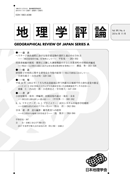Volume 89, Issue 6
Displaying 1-12 of 12 articles from this issue
- |<
- <
- 1
- >
- >|
Original Articles
-
2016Volume 89Issue 6 Pages 283-302
Published: November 01, 2016
Released on J-STAGE: October 05, 2019
Download PDF (865K) -
2016Volume 89Issue 6 Pages 303-328
Published: November 01, 2016
Released on J-STAGE: October 05, 2019
Download PDF (2077K)
Review Article
-
2016Volume 89Issue 6 Pages 329-346
Published: November 01, 2016
Released on J-STAGE: October 05, 2019
Download PDF (1033K)
Research Note
-
2016Volume 89Issue 6 Pages 347-359
Published: November 01, 2016
Released on J-STAGE: October 05, 2019
Download PDF (1915K)
Book Reviews
-
2016Volume 89Issue 6 Pages 360-362
Published: November 01, 2016
Released on J-STAGE: October 05, 2019
Download PDF (375K) -
2016Volume 89Issue 6 Pages 362-364
Published: November 01, 2016
Released on J-STAGE: October 05, 2019
Download PDF (370K) -
2016Volume 89Issue 6 Pages 364-366
Published: November 01, 2016
Released on J-STAGE: October 05, 2019
Download PDF (365K)
MISCELLANEOUS RECORDS
-
2016Volume 89Issue 6 Pages 367
Published: November 01, 2016
Released on J-STAGE: October 05, 2019
Download PDF (145K) -
2016Volume 89Issue 6 Pages 368-370
Published: November 01, 2016
Released on J-STAGE: October 05, 2019
Download PDF (220K) -
2016Volume 89Issue 6 Pages 373
Published: November 01, 2016
Released on J-STAGE: October 05, 2019
Download PDF (150K) -
2016Volume 89Issue 6 Pages 6_cover2-
Published: November 01, 2016
Released on J-STAGE: October 05, 2019
Download PDF (191K) -
2016Volume 89Issue 6 Pages 371-372
Published: 2016
Released on J-STAGE: October 05, 2019
Download PDF (202K)
- |<
- <
- 1
- >
- >|
